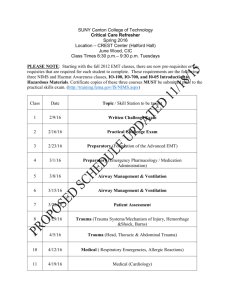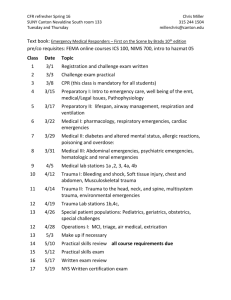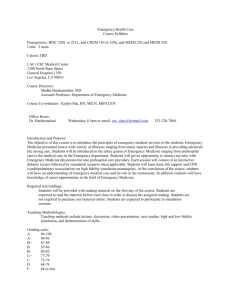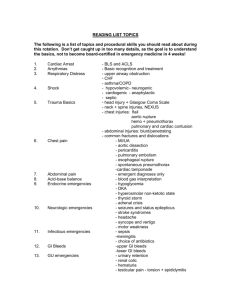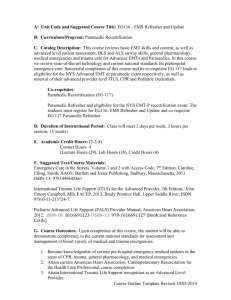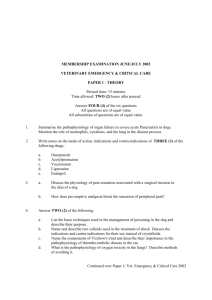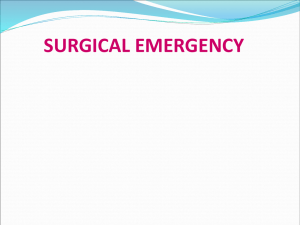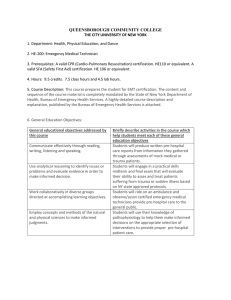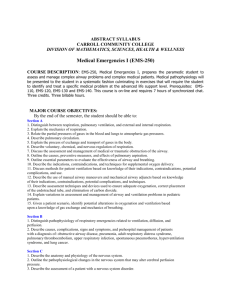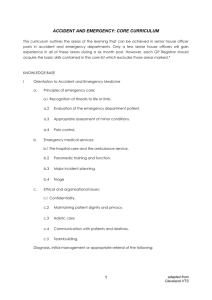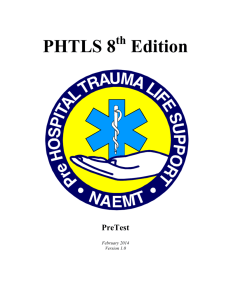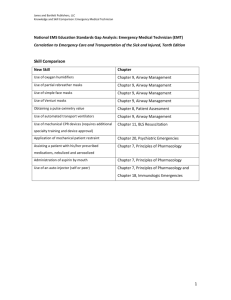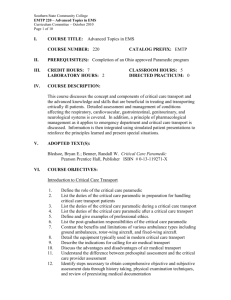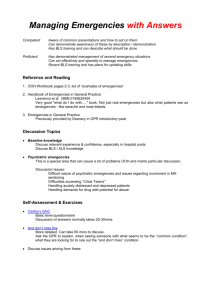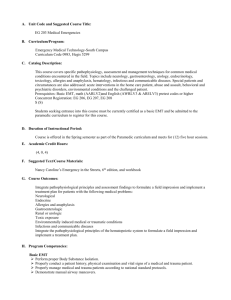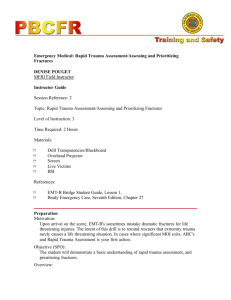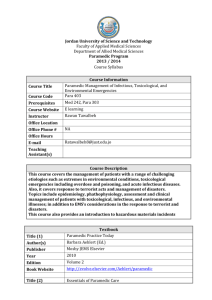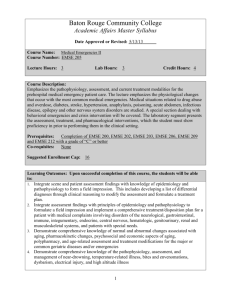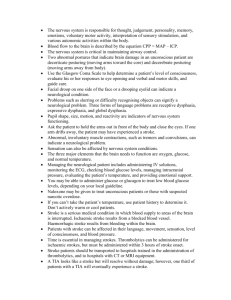system
advertisement
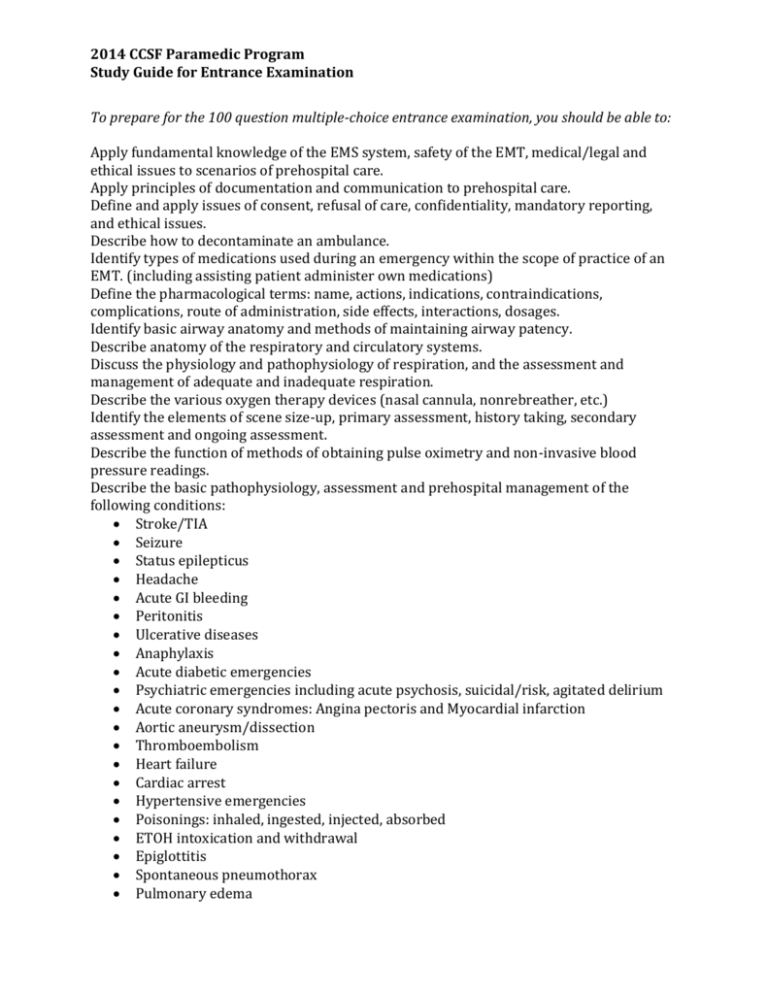
2014 CCSF Paramedic Program Study Guide for Entrance Examination To prepare for the 100 question multiple-choice entrance examination, you should be able to: Apply fundamental knowledge of the EMS system, safety of the EMT, medical/legal and ethical issues to scenarios of prehospital care. Apply principles of documentation and communication to prehospital care. Define and apply issues of consent, refusal of care, confidentiality, mandatory reporting, and ethical issues. Describe how to decontaminate an ambulance. Identify types of medications used during an emergency within the scope of practice of an EMT. (including assisting patient administer own medications) Define the pharmacological terms: name, actions, indications, contraindications, complications, route of administration, side effects, interactions, dosages. Identify basic airway anatomy and methods of maintaining airway patency. Describe anatomy of the respiratory and circulatory systems. Discuss the physiology and pathophysiology of respiration, and the assessment and management of adequate and inadequate respiration. Describe the various oxygen therapy devices (nasal cannula, nonrebreather, etc.) Identify the elements of scene size-up, primary assessment, history taking, secondary assessment and ongoing assessment. Describe the function of methods of obtaining pulse oximetry and non-invasive blood pressure readings. Describe the basic pathophysiology, assessment and prehospital management of the following conditions: Stroke/TIA Seizure Status epilepticus Headache Acute GI bleeding Peritonitis Ulcerative diseases Anaphylaxis Acute diabetic emergencies Psychiatric emergencies including acute psychosis, suicidal/risk, agitated delirium Acute coronary syndromes: Angina pectoris and Myocardial infarction Aortic aneurysm/dissection Thromboembolism Heart failure Cardiac arrest Hypertensive emergencies Poisonings: inhaled, ingested, injected, absorbed ETOH intoxication and withdrawal Epiglottitis Spontaneous pneumothorax Pulmonary edema 2014 CCSF Paramedic Program Study Guide for Entrance Examination Asthma COPD Pulmonary embolism Pneumonia Sickle cell crisis clotting disorders complications related to renal dialysis kidney stones vaginal bleeding sexual assault STD’s Traumatic injuries of the chest, including: hemorrhagic shock, hemothorax, pneumothorax (open/simple/tension), pericardial tamponade, rib fractures, flail chest, commotion cordis Musculoskeletal trauma, including: upper and lower extremity trauma, open fractures, closed fractures, dislocations, sprains/strains, pelvic fractures, amputations Crush syndrome Penetrating neck trauma, larygeotracheal injury, facial/skull fractures, spinal trauma Traumatic brain injury, spinal cord injury Soft tissue trauma and burns (rule of nines to estimate BSA burned) [Identify wound types: avulsions, bites/punctures, lacerations, incisions] Describe the pathophysiology, assessment findings and prehospital management of the following: Complications of pregnancy Normal delivery Abnormal delivery (nuchal cord, prolapsed cord, breech birth) Placenta previa Abruption placenta Spontaneous abortion Ectopic pregnancy Eclampsia/pre-eclampsia Newborn resuscitation Upper airway obstruction in the pediatric patient Respiratory failure and shock in the pediatric patient Seizures in the pediatric patient SIDS Heat/cold related emergencies; high-altitude emergencies, drowning/near drowning Define the elements of the medical incident command system during an MCI Differentiate between the types of shock: cardiogenic, hypovolemic, neurogenic, anaphylactic, septic, obstructive. Describe equipment and skills used to assist during an ALS call.

